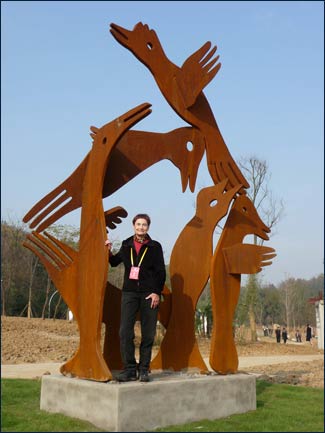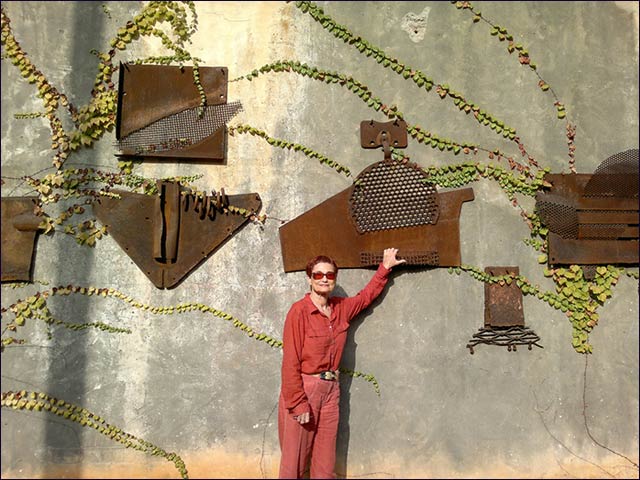By Avigayil Kadesh
Like the timeless bird and angels she fashions from huge pieces of scrap iron, sculptress Dina Merhav is going strong at age 76.
“I want to spread out my sculptures all over the world,” says Merhav. “My ambition hasn’t dimmed with age. I feel I can do more, and better.”
Working out of a studio in Kibbutz Nir Etzion, near her home in the Ein Hod artists’ village near Haifa, the Yugoslavian-born Merhav is one Israel’s foremost environmental sculptors.

Dina Merhav in her workshop.It all started when she was 48 years old, prompted by a November 1989 phone call from Yehuda Izraeli at Nesher Israel Cement Enterprises in Haifa.
At that point, Merhav had been sculpting in stone for about five years following a shift from her 28-year career in graphic design. Someone had noticed her work and recommended her to Izraeli. He asked if she would accept a commission to make a sculpture in the industrial park.
“I visited and saw the enormous mass of scrap iron in the junkyard, and I fell in love with it. I was so fascinated with the enormous, fantastic shapes and also with the soil that was inside it,” Merhav says.
That single commission turned into a decade-long project resulting in the Merhav Nesher Industrial Sculpture Park on the factory’s premises.
Today, Merhav installations can be seen worldwide: in the Guilin YUZI Paradise international sculpture park in southern China, in the Olympic Park in Beijing, in India, Macedonia, Romania, Switzerland, Canada and the United States.

A Merhav sculpture, Heaven’s Harmony,
installed in Wuhu, China In Israel, her creations have been commissioned by the Oil Refinery in Haifa Bay and by municipalities including Kiryat Motzkin, Haifa, Netanya, Maalot, Holon, Ganei Tikvah, Petah Tikvah, Kfar Saba, Yavne, Ramat Hasharon, Hatzerim, Pardesiya and Tel Aviv.
Birds and angels
Merhav’s works range from the abstract to the whimsical. In the past few years, though, she’s developed a decided preference for winged creatures.
A November 2012 exhibition at Artists House Tel Aviv, “Birds in Chinese,” included models, photos, videos and small-scale replicas she has sculpted for Chinese venues, including her 29.5-foot-high Bird of Paradise, now in Shanghai; the award-winning 24.5-foot-high Totem comprised of three fanciful birds; and “Group of Birds.”

Bird of Paradise, now exhibited in Shanghai. Many of her works also depict angels. “Angels and birds have a wish to reach heaven, to be connected with heaven,” she explains.
A six-foot-tall angelic sculpture she called Wings of Peace stands in Geneva. This was her first commission outside Israel, and it has special meaning for the artist.
She relates that after fleeing her hometown of Vincovci (now Croatia) at age five with her mother and younger brother in 1941, they stayed for two years in Italy and then needed to move on. When they attempted to cross the border into Switzerland, they were met with hostility.
“The guards said, ‘Jews out! Only children may enter!’ but we were smuggled in,” she recalls. In 1998, an old family friend originally from Yugoslavia commissioned her to construct Wings of Peace, in memory of the refugees. “I closed the circle,” she says. “I left something of me in the city of peace, where Jews were told to get out.”
Family history in iron
Merhav’s shift to iron sculpting represents another closed circle.
“I am the fourth generation working in iron,” she says. Her great-grandfather built an iron factory that manufactured stoves and agricultural tools. Her father supported his family as an iron trader.

Merhav outside her workshop. The old factory and Bauhaus-style family home in Vincovci still stand, and Merhav may mount an exhibit there next year. A documentary of her work also is planned.
But Israel has become her true home. After the war, during which her father had been a German prisoner of war, she arrived in the Atlit refugee camp in northern Israel at age 13. Miraculously, her immediate family of four was intact, though they had been obliged to leave all their assets behind in Belgrade.
Soon after graduating from Bezalel Academy of Art and Design in Jerusalem at age 21, she married medical student Aryeh Merhav. They divorced amicably in the 1960s, and she kept his last name, as it means “space.” Their son, Yaron, is an advertising executive in Tel Aviv. He and his wife, opera singer Efrat Rotem, have three young daughters.
“The message of all my work is to build a better world – love between all kinds of people and between people and nature, and between all kinds of creatures in the world,” Merhav says.